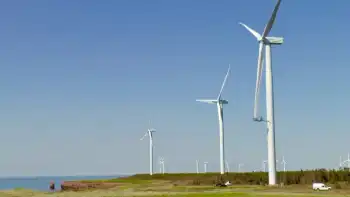Ontario offshore wind stuck in neutral
ONTARIO - The number of wind turbines in Ontario has increased from a handful to almost 800 in just eight years, with wind power now supplying almost three per cent of the province's electricity.
But in recent weeks the wind has dropped out of the sails of the alternative energy industry in the province, with developers unsure about the future direction of wind development in Ontario.
The heady pace of wind development in Ontario has been due in large part to the government's feed-in tariff FIT program. It guarantees a 20-year price of 13.5 cents per kilowatt-hour kWh for wind projects.
But on February 11, the government announced a moratorium on all offshore wind development, saying more research was needed to determine health and environmental impacts, particularly with respect to projects in the Great Lakes.
The decision was aimed at offshore development, not on-shore projects. Even so, Ontario's reputation as a leader in the green energy economy is being threatened by an inconsistent and ad hoc policy on wind development, renewable advocates say, threatening several projects and the prospect of future manufacturing jobs.
"So far all offshore wind development has taken place in salt water," explains Jonathan Rose, press secretary for the Minister of the Environment John Wilkinson. "That is very different than fresh water like Lake Ontario, which is, obviously, a source of drinking water for millions of Ontarians."
The ministry also wants to study the impact on local ecology, including fish and birds, as well as how noise from wind turbines travels over water, he says.
It plans to do this by studying planned projects in the U.S. and the only operational freshwater turbine in the world, located in Sweden's Lake Vanern.
John Kourtoff, CEO of Trillium Power Wind, which plans to build a 420 MW wind farm off Prince Edward county, says the government already conducted its studies and gave the go ahead in 2008 when it lifted a previous moratorium imposed two years earlier.
A 2008 press release from the Ministry of Natural Resources announcing the end to the last moratorium says the government analyzed lakes Erie, Ontario and Huron based on depth, wind speed and "other social and ecological values."
"They said it was full steam ahead at the time," Kourtoff says, adding his company has conducted 104 studies that are complete or "90 per cent complete" on environmental and health effects, including avian, aquatic and water impacts.
Moreover, he says, the Trillium project will be located between 17 and 28 kilometres off the coast, far out of sight of residents.
Nevertheless, the Ministry of the Environment sought public input following the end of the previous moratorium and based on the feedback had to halt future development, says Rose.
"We received over 1,400 comments and those comments raised more questions than answers, so unless we can take a cautious, scientific approach, we had to declare a moratorium," he says.
The Ministry of the Environment, notes Rose, did not grant any approval to offshore wind projects. The Ministry of Natural Resources was responsible for the first halt and that is separate from the current stoppage.
For its part, the Ontario Power Authority OPA, which offers FIT contracts, states on its website that applications from offshore will no longer be accepted and current ones have been cancelled.
John Laforet of Wind Concerns Ontario says the most recent halt shows the government stand on turbines is on shaky scientific ground.
"It's the second time they've put a moratorium in place and just admitted that they don't know what they're doing when it relates to offshore wind," says the president of the group, which represents 57 community-based groups who are opposed to all wind development.
Several European countries, including England, Denmark and Germany, have large-scale offshore sites, though these are all in salt water.
The Great Lakes are ideal for offshore wind development because of high wind speeds and shallow water, says Kourtoff. This is particularly true for the Canadian side of the lake, because wind picks up speed as it blows along the surface in a northeasterly direction.
Denmark is the global leader in converting wind energy into power, supplying about 19 per cent of its electricity needs from wind farms. Spain and Portugal follow, generating about 10 per cent of their total power supply from wind. By comparison, Canada generated about 0.46 per cent of its power from wind in 2010.
Offshore projects, environmental advocates note, tend to receive more consistent wind speeds, can be much larger and, if located far enough offshore, tend not to engender the sort of opposition onshore turbines are known for.
Indeed, a 2010 study by the Conference Board of Canada found there to be as much as 35,000 MW of potential offshore electricity in Ontario alone. And at least two other projects were looking to harness this power.
Along with Trillium, Windstream Energy was in the process of developing a 300 MW project on the Wolfe Island Shoals near Kingston and Toronto Hydro was considering a wind farm off the Scarborough Bluffs.
Exploiting this resource could go a long way towards the government's goal of increasing renewable generation to 10,700 MW, Kourtoff explains. Besides, he says, the U.S. is already pressing ahead with plans to exploit the breezes of the Great Lakes.
A 20 MW pilot project based near Cleveland in Lake Erie is in the planning stages, and the New York Power Authority plans to award a contract for up to 500 MW of generation based somewhere in the Great Lakes region, though a final decision is not expected until this summer.
Although Kourtoff and Laforet may disagree vehemently about wind power — its per-kilowatt price, the environmental or health effects and, more fundamentally, whether it should be used at all — both agree that the current moratorium has cast an ominous shadow over the offshore wind power industry in Ontario.
"The benefit for us is its going to chase serious investors out of this province," says Laforet from Wind Concerns, "because you have to be out of your mind to put any money for offshore industrial wind if the province is going to go back and forth like this."
"It's good for us because it's going to kill the offshore industry," he says.
Kourtoff says the moratorium can last no more than two or three months before it does irreparable harm to province's emerging wind industry. "The problem is it's already getting too late," he explains. "The message is getting out that Ontario has halted, and possibly harmed, its offshore sector permanently."
Kourtoff says this could also jeopardize long-term economic development as turbine manufacturers decide to settle elsewhere.
The 2010 Conference Board of Canada study calculated the economic benefits of just 2,000 MW of offshore wind — which it noted was a "conservative" estimate given conditions. Real gross domestic product would increase by $5.5 billion and the development would create 600 permanent jobs and as many as 4,400 during construction.
The government doesn't know how long it will take to reach a decision and wants to make sure it gets the science right, Rose says.
"We don't want to put a timeframe on it, it depends on the amount of time it takes to complete the required research," he says.
For Kristopher Stevens, executive director at the Ontario Sustainable Energy Association, which aims to foster community-owned renewable power, it is part and parcel of a guarded embrace of wind power in Ontario. He notes that setbacks for onshore sites are 550 metres in Ontario compared to 350 metres in Germany, which has had a much more robust wind industry for a longer period of time.
He says its too early to tell what impact the moratorium will have on Ontario's plan to increase its percentage of renewable power.
"The delay regarding offshore wind definitely slows things, but it points out the cautiousness of our government," he says, adding that as Ontario phases out all coal generation by 2014 it will need to rely on a mix of different energy sources, not just wind.
On the other hand, he says, it really is a question of timing.
"If we look south of the border, some of the other states are pushing ahead with offshore wind," he says. "So the question for us is: Can we do our science quickly and effectively enough that we don't lose the leadership position that we had?"
Either way, he says, the clock is ticking for the province. "I think the window is fairly short."
Related News

Ottawa won't oppose halt to Site C work pending treaty rights challenge
VANCOUVER - The federal government is not going to argue against halting construction of the controversial Site C hydroelectric dam in British Columbia while a B.C. court decides if the project violates constitutionally protected treaty rights.
Work on Site C suspended prior to First Nations lawsuit
However a spokeswoman for Environment Minister Catherine McKenna said Monday the government will continue to defend the federal approval given for the project in December 2014, even though that approval was given using an environmental review process McKenna herself has said is fundamentally flawed.
The Site C project is an 1,100-megawatt dam and generating station on the…




